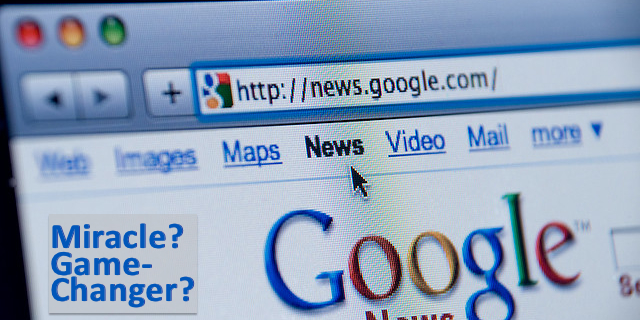“Whether they realize it or not, journalists reporting on health care developments deliver public health messages that can influence the behavior of clinicians and patients.” ~Susan Dentzer
Hope
 Hope is powerful. It should be treasured and protected. It keeps humans moving forward, despite enormous obstacles. This is especially true for people with chronic conditions and cancer. Hope keeps you going, despite the odds.
Hope is powerful. It should be treasured and protected. It keeps humans moving forward, despite enormous obstacles. This is especially true for people with chronic conditions and cancer. Hope keeps you going, despite the odds.
That’s why Vinay Prasad, MD, MPH, of Oregon Health & Science University in Portland, and Matthew V. Abola, at Case Western Reserve University School of Medicine, did a quick and dirty assessment of health news between June 21st and June 25th. They shared their results in a letter to JAMA Oncology. Their content analysis revealed that 94 news articles on cancer treatments used the words “breakthrough,” “game changer,” “miracle,” “cure,” “home run,” “revolutionary,” “transformative,” “life saver,” “groundbreaking,” and “marvel.” Forty-seven of the articles used these words to discuss drugs that hadn’t even been approved by the FDA. Fourteen percent used these words on drugs that have only been tested on mice; not humans.
In an interview with NPR, Prasad explained his experience as a practicing oncologist. Patients come into his office asking if a “breakthrough” or “miracle” drug they’d seen in the news would help them. “You don’t want to say ‘No, forget about it,’ ” says Prasad. “We want as oncologists to foster something called reasonable optimism, reasonable hope.”
Writing that sensationalizes can raise hopes–only to dash them again and again.
That Problematic Word “Breakthrough”
Webster’s defines “breakthrough” as “an important discovery that happens after trying for a long time to understand or explain something.”
The FDA is now using the word “breakthrough” on a regular basis but with a different meaning. Since July 9, 2012
“A breakthrough therapy is a drug:
• intended alone or in combination with one or more other drugs to treat a serious or life threatening disease or condition and
• preliminary clinical evidence indicates that the drug may demonstrate substantial improvement over existing therapies on one or more clinically significant endpoints, such as substantial treatment effects observed early in clinical development.If a drug is designated as breakthrough therapy, FDA will expedite the development and review of such drug.”
In other words, a “breakthrough” therapy is a designation given to a drug by the FDA to hurry up its approval process. This designation is NOT the same as the everyday definition of “breakthrough.”
The Importance of a Word
Prasad and Abola aren’t the only ones wondering about the word “breakthrough.” In a survey conducted in June 2014 and published in JAMA Internal Medicine, researchers created 5 vignettes to describe a recently approved drug. One was a “facts only” description where no use  of the words “promising” or “breakthrough” occurred. One description used the word “promising” and another used the word “breakthrough.” The fourth and fifth modified the use of the word “breakthrough” with a tentative or a definitive explanation respectively. The participants were randomly assigned one of the vignettes to read, then they completed questions about the drug’s benefits, harms, and the strength of the evidence about those benefits and harms.
of the words “promising” or “breakthrough” occurred. One description used the word “promising” and another used the word “breakthrough.” The fourth and fifth modified the use of the word “breakthrough” with a tentative or a definitive explanation respectively. The participants were randomly assigned one of the vignettes to read, then they completed questions about the drug’s benefits, harms, and the strength of the evidence about those benefits and harms.
The researchers found that using the words “breakthrough” or “promising” significantly increased participants rating the drug very or completely effective. Additionally, use of “breakthrough” or “promising” resulted in the participants rating the presented evidence of efficacy as strong or extremely strong.
In other words, using “breakthrough” and “promising” may interfere with a readers’ judgements.
The FDA’s use of the word “breakthrough” may be adding to the problem.
Fallout of Simplified and Exaggerated Reporting
Some journalists are reviewing their mistakes. On January 2, 2015, Jennifer Couzin-Frankel wrote an article for Science titled, “The bad luck of cancer.” The piece was supposed to explain a mathematical analysis, conducted by Bert Vogelstein and Cristian Tomasetti of Johns Hopkins University, that clarified how cancer starts.
In her explanation, Couzin-Frankel wrote that the researchers’ analysis of the “genesis of cancer …suggests many cases are not preventable.” Specifically, her article said that “2/3 of all cancers were caused by bad luck.”
In a January 13th follow-up article, Couzin-Frankel wrote,
“I’d written that the theory of random mutations in stem cells ‘explained two-thirds of all cancers.’ Immediately, I knew that I had written part of that sloppily, to put it generously: [emphasis added] The study didn’t include all cancers. In fact, it didn’t include two of the most common, prostate and breast, because the authors weren’t able to pin down the size of the stem cell compartment or the frequency of stem cell divisions in those tissues.”
Unfortunately her mistake has gone viral. Entering “2/3 of all cancer cases are due to bad luck” into the Google search engine generates over 1,420,000 search results. In the Internet age, errors proliferate.
The Complexity of Health and Health Research
Susan Dentzer in her 2009 article in the New England Journal of Medicine points to the problem of journalism education. It may be that these writers have too little education to  understand some of the nuances of health research or for that matter, statistics. Couzin-Frankel, herself, inferred a lack of statistical understanding in her follow-up article.
understand some of the nuances of health research or for that matter, statistics. Couzin-Frankel, herself, inferred a lack of statistical understanding in her follow-up article.
The problem may also have to do with a desire to package complicated information into sound bites. Or it may have to do with the importance placed on “news being new.” Newness gets the front page, or the first story in the news program.
Apparently, researchers and physicians may also be attempting to increase their visibility. For example, in Prasad and Abola’s content analysis, although journalists were the most likely to use “superlatives,” 27% of the physicians also used them.
As Susan Dentzer wrote in 2009,
“I believe that when journalists ignore complexities or fail to provide context, the public health messages they convey are inevitably inadequate or distorted. The news media need to become more knowledgeable and to embrace more fully our role in delivering to the public accurate, complete, and balanced messages about health.”
The Importance of Questioning
When you were small you probably heard this old saw from your parents, “if it sounds too good to be true, it probably is too good to be true.” As a patient or caregiver, it is important to keep this saying in mind and to be aware of what drives the News business.
An Issue of Trust
The question remains, should patients and caregivers be burdened in this way? Indeed, exaggerating hope through misrepresentation to sell news debases the work of physicians, nurses, patients, caregivers, and researchers–those individual heroes in the healthcare system. If healthcare news cannot be trusted, what can people rely upon? Is building up and shattering the hope of patients and caregivers really worth the short-term benefit of the front page? These are questions health journalists and editors need to ask themselves.
Hope is our light in the darkness-a fragile, yet precious glow.







Unfortunately, I think this kind of hyperbole is more about getting investors rather than actually being of benefit to the public.
Thank you for your comment.
I was checking to see what drug trials are coming up.
This is an excellent piece that all communicators in the healthcare field should take to heart. It is challenging to interpret scientific information in a way that is both accurate and meaningful for broad audiences. Our words have meaning, we need to use them wisely.
It was hardly necessary to conduct research to quantify the media’s hyperbolic language in reporting medical news, and to see its effects on people’s attitudes and expectations about health, illness, and clinical care. Thirty years ago, I wrote editorials for a small medical journal making that same point, without doing any research–it wasn’t necessary. One need not measure the exact rate of precipitation to realize that standing outside in the rain means getting wet.
Thank you Kathleen, I’m sometimes frustrated when the headline doesn’t produce the goods in the text